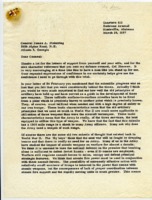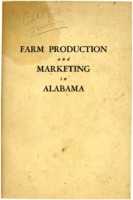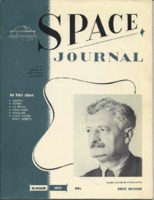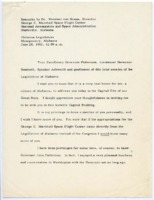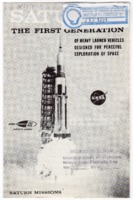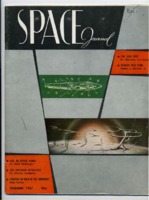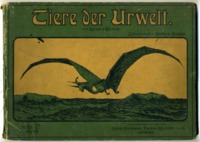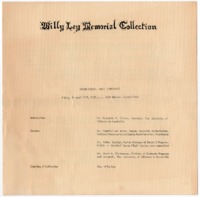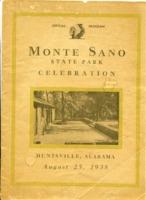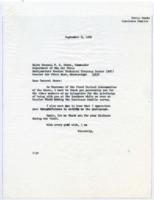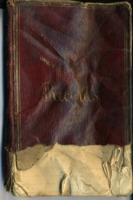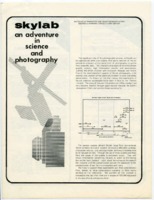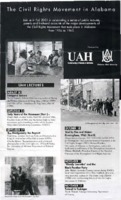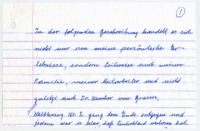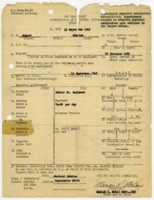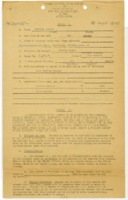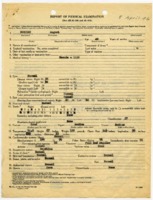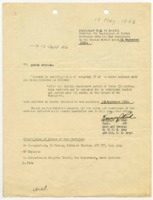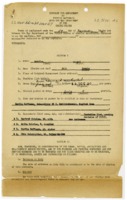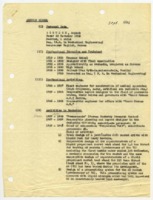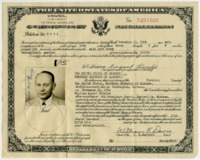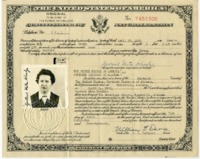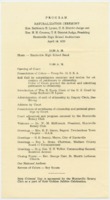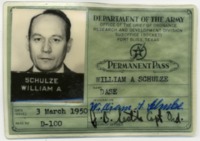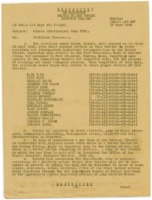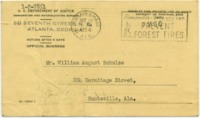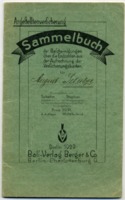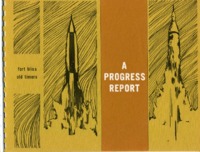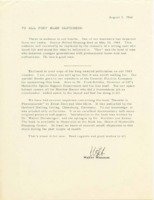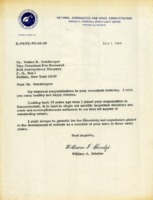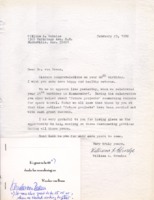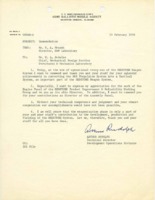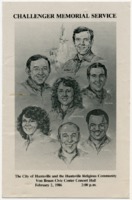
Browse Items (2178 total)
Sort by:
-
Abbreviated timeline of the Apollo 11 mission.
The timeline includes a memorandum from Friedjof A. Speer, manager of the Missions Operations Office, to employees of Marshall Space Flight Center. Speer notes that "astronaut Neil Armstrong is scheduled to be the first man to step onto the moon's surface." The timeline outlines the entire mission from liftoff at 8:32 AM on Wednesday, July 16, 1969 to splashdown at 11:49 AM on Thursday, July 24, 1969. -
Letter from Col. John C. Nickerson at Redstone Arsenal in Huntsville, Alabama, to Gen. James A. Pickering in Atlanta, Georgia.
In this letter, Nickerson thanks Gen. Pickering for his support and explains why he believes the Army is the best service branch to develop ballistic missiles. He also discusses the need for missiles in case of war with the Soviet Union. Nickerson was a staff officer at the Army Ballistic Missile Agency at Redstone Arsenal assigned to work on the Jupiter, the United States' first mid-range ballistic missile. He was arrested and court martialed for espionage in 1957 after releasing sensitive documents about the United States missile program to the press. At the time, Secretary of Defense Charles E. Wilson granted the Air Force sole authority to develop intermediate range ballistic missile systems. Nickerson disagreed with this policy, and in response, leaked documents that demonstrated the superiority of Army missiles compared to those developed by the Air Force. He eventually pled guilty to lesser charges and was suspended from the Army for one year and was fined $1,500. Dr. Wernher von Braun was among those who testified on Nickerson's behalf. -
Space Journal, vol. 1, no. 1., Summer 1957.
This issue of Space Journal includes articles written by Fred L. Whipple, Hermann Oberth, and Ernst Stuhlinger, as well as a foreword by Wernher von Braun. The issue also includes drawings for an observatory to be built at the top of Monte Sano Mountain in Huntsville, Alabama. Produced by the Rocket City Astronomical Association (now known as the Von Braun Astronomical Society), Space Journal was published in Huntsville from 1957 to 1959. This digitized copy was generously provided by Jeff Bennett at the Von Braun Astronomical Society (VBAS). -
"Your Family Survival Plan."
The pamphlet instructs readers how to build a fallout shelter and includes instructions for storing food and water, specifications for building materials, and charts for keeping track of food and water supply, shelter supplies and equipment, and first aid. -
Transcript of a speech given by Wernher von Braun to the Alabama Legislature.
Von Braun, then the director of Marshall Space Flight Center in Huntsville, Alabama, delivered this speech to the legislature in 1961. In the speech, he emphasizes that Alabama must take advantage of its position in the aerospace industry and create a robust "academic and research environment" in Huntsville to attract businesses that "will give birth to major new industries throughout the state." He exhorts the legislature to fund the newly established University of Alabama Research Institute (now part of the University of Alabama in Huntsville), arguing that "the Institute will not only be self-sustaining, but will enrich the State both financially and culturally." The legislature later approved von Braun's request of $3 million for the Research Institute, enabling the purchase of 200 acres of land for the campus and the construction of the Institute in 1964. The speech includes copies of slides von Braun used during his presentation, including diagrams of Saturn and Nova rockets as well as a mockup of a Saturn rocket on the lawn of the state capitol in Montgomery. -
"Saturn I: The First Generation of Heavy Launch Vehicles Designed for Peaceful Exploration of Space."
The leaflet outlines the history of Saturn launches and gives a physical description of the rocket. The description includes a diagram of each stage; specifications of each stage's thrust, propellants, liftoff weight, and burning time; and engine specifications. -
Transplanted Rocket Pioneers.
The information in this dataset is reproduced from Charles Lundquist's 2014 monograph Transplanted Rocket Pioneers. The information includes biographical and professional information that he compiled to produce the book. Each individual represented in the dataset also has a vertical file in the Lundquist Collection at UAH.
Transplanted Rocket Pioneers is a recognition of the early members of the von Braun rocket team, many of whom were key players in the successful moon landing. Many historians conclude that the lunar missions of the Apollo Program could not have been possible without the leadership and experience provided by a corps of engineers, scientists and managers transplanted from Europe to the Unites States after World War II. This fact motivated Dr. Lundquist to deposit this work in the Archives of the Library at the University of Alabama in Huntsville by assembling a file on each of the individuals who came from Europe to participate in the rocketry activities in Huntsville, or, in a few cases, individuals who had other ties to Huntsville.
This dataset includes a standard one-page summary sheet for each subject. Although most sheets are relatively complete, some data are still missing.
The first two lines on each page records fundamental identification information:
Family name Date of birth Place of birth Given names Date of death Place of death
The next standard entry is a statement of the extent of the Archives Holdings, either i) A primary collection of documents housed in one or more banker boxes, usually a separate individual collection ii) A secondary collection in a standard archive box, or iii) a file folder. Next, if there is an oral or video history for the individual, this fact is noted. A statement about the highest education levels of the individual follows. The next five entries, in chronological order, record whether the individual participated in activities at five sites:
1. Raketenflugplatz-Kummersdorf: Individuals engaged in the activities at these sites of early rocket development experiments sponsored first by VfR and subsequently by the German Army.
2. Peenemünde: Included here are individuals who participated in Peenemünde programs under several auspices, including as Army civilian employees, as members of the German military, as contractor employees on site or visiting as needed, and as university employees collaborating as required.
3. Fort Bliss: Individuals who were brought to Fort Bliss from 1945 to 1950.
4. GMDD-ABMA: Individuals who came to Huntsville, Alabama to work for the US Army rocket programs in the decade 1950 to 1960.
5th MSFC: Individuals who were employed by the NASA Marshall Space Flight Center in the 1960s.
Some people had various relationships with UAH and that is so noted. Additionally, a statement of immigration details is noted if pertinent. Finally, a great variety of incidental information is included under Incidental Remarks.
UAH Special Collections welcomes additions of biographical materials to the vertical file in the Charles Lundquist Collection. Please note that the work is that of Dr. Lundquist and may contain errors or omissions which are solely the product of his work on the project, as noted in the introduction of the work.: " Finally, it is pertinent to note that any document containing large files will surely have some mistakes or omission. Any errors are the responsibility of the author alone." As was the wish of Dr. Lundquist, we will strive to make factual corrections to the online copy when necessary.
-
Tiere der Urwelt: in 30 Kunstblättern nach wissenschaftliche Material bearbeitet.
This set of illustrated cards includes thirty color prints of various animals of the prehistoric world. The Theodor Reichardt Cocoa Company produced five different series of these cards in the early twentieth century. While the cover indicates that this volume contains cards from series 1a, it also includes cards from series 1 and series 2a. Many of the pages show notes made in ink by science writer Willy Ley, the book's original owner. -
Program from the dedication and opening of the Willy Ley Memorial Collection at the UAH Library.
The program includes a diagram of the arrangement of the collection, a brief biographical sketch of Ley, and a program for the "Ley Memorial Symposium on Science and Technology in the 1970's." Willy Ley died in 1969. The UAH Library purchased his book collection from his widow, Olga Ley, in 1970. -
Official program of the Monte Sano State Park Celebration.
This celebration was held on the park's opening day. Events included a parade, an address given by Speaker of the U.S. House of Representatives William B. Bankhead, a history pageant, and a "Queen's Ball" that evening at the Russel Erskine Hotel. The program includes a description of the cabins, the "Legend of Monte Sano," a history of Huntsville, and a program for the history pageant, titled "The Parade of Progress." -
Materials from Rep. Bob Jones' visit to Keesler Air Force Base in Biloxi, Mississippi after Hurricane Camille.
The materials include correspondence between Jones and Major General T. E. Moore, commander of the Keesler Technical Training Center, and a photo of Jones with Moore, Congressman William Colmer of Mississippi and General Sam Maddux. -
Civil War diary of George Washington Harris.
Harris served as a private in Company F of the 149th Indiana Infantry Regiment, which occupied Decatur, Alabama in 1865. He enrolled at Terre Haute, Indiana, on February 15, 1865 at the age of twenty. Harris records his experiences as a soldier and traces his journey south to Decatur. Harris also describes his interactions with locals in North Alabama, writing in April 1865 that he "halted to talk with a family of Rebbs questioning concerning their so-called independence but found out nothing of importance Except that ther hopes had fled." He also includes descriptions of skirmishes in which he took part, as well as lengthy descriptions of the terrain and weather. Harris adds his comments on the assassination of Abraham Lincoln and writes down song lyrics and poetry at points. Harris was discharged on September 27, 1865. -
"Skylab: An Adventure in Science and Photography."
This leaflet gives an overview of types of film and camera systems being used in photography and observations on Skylab, the first space station launched by the United States. -
Flier advertising the Civil Rights Movement in Alabama 1954-1965 Lecture Series.
This pamphlet features photographs taken by Alabama photographer Charles Moore during the civil rights era. Speakers listed include Fred Gray, Fred Shuttlesworth, Sonnie Hereford, and John Lewis. -
Autobiography and résumé of William August Schulze.
In this partial autobiography, Schulze describes his experiences growing up in Neulaubusch, Germany and training and working as an engineer. He notes that he began working for Wernher von Braun at Kummersdorf in 1936 and then moved to Peenemünde, where he worked on the A-3, A-5, A-7, and V-3 rockets. The documents also include a lengthy handwritten excerpt from Schulze's 1945 day book and a résumé. Includes a transcription and a partial English translation. -
U. S. War Department Notification of Personnel Action.
This document includes details about Schulze's transfer to the United States after World War II, including his health and the terms of his employment as an engineer. -
Letter from August Schulze in Aberdeen, Maryland to Trude and Erika Schulze in Landshut, Bavaria, Germany.
Schulze wrote this letter to his wife, Trude, and daughter, Erika, on the back of a photostat copy of his War Department Notification of Personnel Action. In the letter, he discusses his pay and accommodations with the U. S. Army. -
Special Contract for Employment of German Nationals with the War Department in the United States.
This special contract outlines the conditions of August Schulze's employment as an engineer in the United States. The document also includes instructions regarding the engineers' housing, dependents, mail, termination of contract, and burial. -
Report of Physical Examination.
This report documents August Schulze's physical condition after his arrival in the United States. -
Supplements to Special Contract for Employment of German Nationals with the War Department in the United States.
The two supplements extend August Schulze's employment in the United States to November 21, 1946. On the back of Supplement No. 2, Schulze lists amenities and their prices. -
Contract for Employment of Foreign Nationals with the War Department of the United States.
This contract outlines employee benefits, policies regarding the movement of dependents from Germany to the United States, and conditions of secrecy, noting that "as a condition to admittance to this country and employment hereunder, employee agrees to observe such security measures as the President of the United States may direct with respect to the project here involved." The contract also includes an enclosure clarifying that Schulze's wife and daughter may move to the United States as soon as possible. -
Résumé of August Schulze.
This résumé outlines Schulze's professional activities and activities in rocketry. The document notes his interrogation by the United States and outlines plans for his "Contemplated Activity" as "Chief of the Subsection 'Thrust Unit'." -
Certificate of Naturalization for Gertrud Meta Schulze.
Gertrud Schulze was naturalized on the same day as her husband, William August Schulze. The back of the certificate notes that her name was legally changed at the same time she was naturalized. -
1946 day book.
Written by William A. Schulze, this day book includes notes from his activities at Army Proving Ground at Aberdeen, Maryland in early 1946. Schulze was transported from Germany to Aberdeen in late 1945 as part of the first group of German engineers sent to the United States. During the week of March 17-23, Schulze records his travel from Aberdeen to El Paso, Texas, leaving on Monday, March 18, and arriving in Texas on Thursday, March 21. The day book includes entries on shopping, leisure activities, birthdays, and mail. Schulze's notes reference H. N. Toftoy, Konrad Dannenberg, Wilhelm Jungert, Hannes Luehrsen, Theo Poppel, Erich Neubert, Walter Schwidetski, and others. -
Naturalization ceremony program.
Held at the Huntsville High School auditorium, the ceremony naturalized many of the German engineers who were transferred to Huntsville in 1950. -
Department of the Army Permanent Pass.
This pass was issued by the Office of the Chief of Ordnance, Research and Development Division Suboffice (Rocket), at Fort Bliss, Texas. -
Orders for the transportation of seventeen German civilians to the United States.
This document identifies the first group of German engineers to be brought to the United States as part of Operation Paperclip. Seven of the men listed were eventually transported to the U. S. Army post at Fort Bliss, Texas: Wernher von Braun, Wilhelm Jungert, Erich Neubert, Theo Poppel, Eberhard Rees, August Schulze, and Walter Schwidetski. The men were transported from Germany by air and then by train once in the United States. -
"Notice to Petitioner."
This card was sent from the U. S. Department of Justice Immigration and Naturalization Service in Atlanta, Georgia to William August Schulze. The card serves as notification of his naturalization hearing at the Post Office Building in Birmingham, Alabama, on November 11, 1954. Typed instructions at the bottom of the card read, "BRING YOUR ALIEN REGISTRATION CARD WITH YOU." Schulze was later naturalized in Huntsville on April 14, 1955. -
German state health insurance book and cards belonging to William August Schulze.
This booklet, "Sammelbuch der Bescheinigung über die Endzahlen aus der Aufrechnung der Versicherungskarten für August Schulze," documents Schulze's government health insurance while he was employed in Germany from 1930 through 1944. Each page serves as an insurance card for each year of employment. Page seven marks Schulze's first insurance record as an employee at Peenemünde. -
"Fort Bliss Old Timers: A Progress Report."
Subtitled "Some of the Old Timers' Contributions to the Science of Space," this booklet commemorates the accomplishments of the group of engineers posted at Fort Bliss, Texas, beginning in 1945. It includes a brief history of rocket development in Germany from 1929 through 1944, photographs of the 1965 Old Timers Reunion, and a directory of the oldtimers. It also includes a transcript of a speech given by Wernher von Braun in honor of Walter Dornberger's retirement. -
1963 Fort Bliss Old Timers Reunion booklet and letter.
The materials include a letter from Walter Wiesman and an Old Timers Reunion booklet. The booklet includes reproduced news clippings, the reunion program, and photographs from Fort Bliss, as well as photographs of reunion attendees and activities with subjects identified. The reunion booklet also includes photographs from a meeting of the Alabama Section of the American Institute of Aeronautics and Astronautics. -
Correspondence between William A. Schulze in Huntsville, Alabama, and Walter Dornberger in Buffalo, New York.
In his letter to Dornberger, Schulze congratulates him on his seventieth birthday and notes, "Looking back 29 years ago when I joined your organization in Kummersdorf, it is hard to single out specific important decisions you made and accomplishments achieved; to me they all appear of outstanding nature. I shall always be grateful for the friendship and experience gained in the development of rockets as a member of your team in those early years." Dornberger's reply is enclosed. -
Correspondence related to Wernher von Braun's sixtieth birthday.
The materials include a congratulatory note from William A. Schulze to von Braun, in which he notes, "To me it appears like yesterday, when we celebrated your 25th birthday in Kummersdorf." Von Braun's response, handwritten on a card, reads: "It was also great to be 25 or so, when we started working together!" Enclosed are instructions from Eberhard Rees encouraging Marshall retirees to send von Braun personalized birthday wishes for inclusion in a bound volume later. -
Program from the Challenger disaster memorial service held in Huntsville, Alabama.
The service was held in downtown Huntsville at the Von Braun Civic Center Concert Hall. The program includes remarks from Edward O. Buckbee, Mayor Joe Davis, and Alabama's Teacher in Space finalist Robert Kirchner. -
Transcript of the Civil War diary of George Washington Harris.
Harris served as a private in Company F of the 149th Indiana Infantry Regiment, which occupied Decatur, Alabama in 1865. He enrolled at Terre Haute, Indiana, on February 15, 1865 at the age of twenty. Harris records his experiences as a soldier and traces his journey south to Decatur. Harris was discharged on September 27, 1865. The transcription includes a key to the cipher that Harris sometimes used, as well as notes and clarifications in brackets and parentheses. Also included are the complete lyrics to the Union song "Reply to the Bonnie Blue Flag," part of which Harris records in an entry here.

